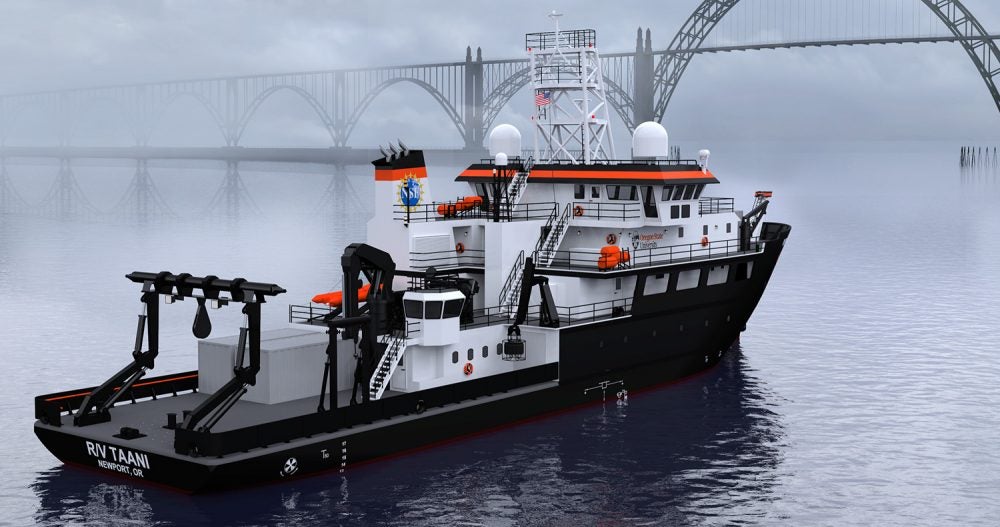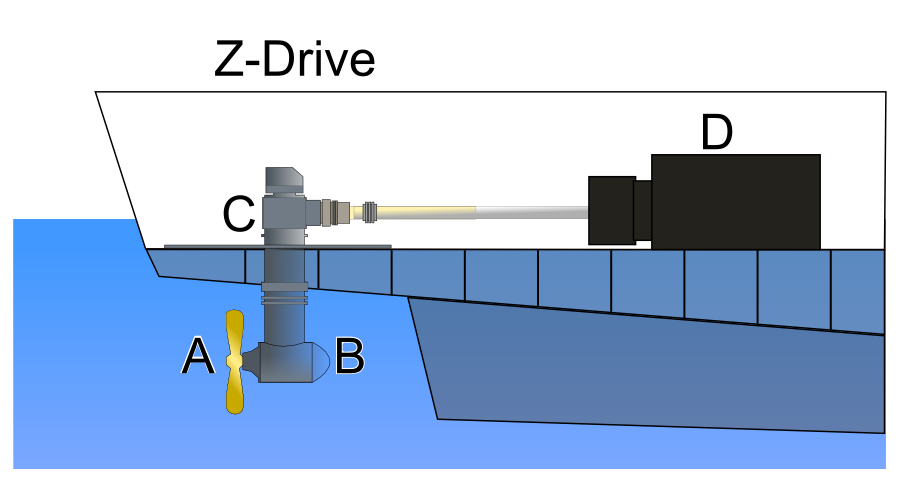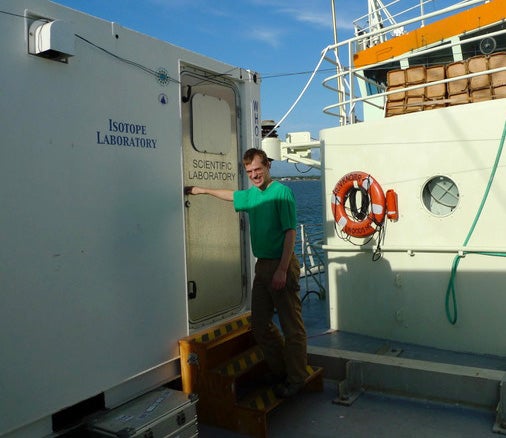The regional class research vessels (RCRVs) under construction are modern monohull ships with integrated diesel-electric propulsion that are capable of general-purpose interdisciplinary oceanographic research. The ships can operate in coastal regions worldwide, make open ocean transits, and operate in or around light first-year ice.
Ship Progress Update:

Project Lead: Oregon State University
 In early 2013, the National Science Foundation (NSF) selected Oregon State University’s College of Earth, Ocean, and Atmospheric Sciences (OSU) to lead design, construction, and trial phases of the RCRV program. The first of NSF’s three new research vessels, R/V Taani, will be operated by OSU along the U.S. Pacific coast, while the third ship, R/V Gilbert R. Mason, will be operated by the Gulf-Caribbean Oceanographic Consortium.
In early 2013, the National Science Foundation (NSF) selected Oregon State University’s College of Earth, Ocean, and Atmospheric Sciences (OSU) to lead design, construction, and trial phases of the RCRV program. The first of NSF’s three new research vessels, R/V Taani, will be operated by OSU along the U.S. Pacific coast, while the third ship, R/V Gilbert R. Mason, will be operated by the Gulf-Caribbean Oceanographic Consortium.
During the design phase, OSU engaged marine architects Glosten Associates of Seattle, Wash.
Bollinger Houma Shipyards in Houma, La., was selected by Oregon State University to build all three of the NSF’s newest RCRVs.
Capabilities
Attributes of the new RCRVs reflect the NSF’s desire to operate fewer, more capable, vessels. Here are a few key reasons why these new ships fit the bill and anticipate how marine research and exploration will be conducted in the coming decades.
Sea Keeping
Bilge keels, a retractable centerboard, a wider beam, and especially the “U-Tube” will greatly reduce roll. The new RCRV will be able to run parallel to troughs, rather than turning the bow into waves and swells. By drastically reducing pitch and roll, every over-the-side deployment can be made more safely, especially deployments in rougher seas. Advanced sea-keeping capability means the ship can operate in more severe weather and more days per year.
What‘s a “U-Tube?”
A U-Tube is a ballast tank that counteracts wave motion to keep a ship’s roll to a minimum. Inside the tank, ballast water is quickly shifted laterally—from port to starboard and back again—to rebalance the vessel’s center of gravity. U-Tube tanks enable ship operators to “lean in” to the ocean’s sideways push.
Efficiency
These new RCRVs are designed to operate as efficiently as possible. By thinking in terms of “data per dollar,” ship designers set out to increase data collection and decrease the cost to do it. Efficiencies and a reduced carbon footprint are achieved by:
- A bulbous bow that reduces drag
- Variable-speed power generation
- LED lighting
- High-efficiency pumps and motors
- Waste heat recovery
Ice Classification
Interest in research operations in polar regions, where sea ice is prevalent, is expected to increase in coming decades as the regions become more accessible. Currently, no intermediate or regional class vessel is certified for safe operation when sea ice is present. All three RCRVs are being built to meet the “ABS C0” ice classification. They’ll be able to safely and independently operate in areas of open first-year ice coverage, where at least 60% of the ice is less than one foot thick.
Dynamic Positioning
Dynamic positioning (DP) is achieved with two “Z-drives” working in concert with two bow thrusters to deliver propulsion with exacting navigation. A vessel equipped for DP can safely hold station over a wide range of environmental conditions. Position-critical missions, such as precise ROV tracking, will occur more often and be easier to perform. DP systems also enable a vessel to dock safely in rough weather, to operate in estuaries or rivers, and maneuver closer to navigational hazards.

What‘s a “Z-Drive?”
Propulsion by Z-Drive eliminates the need for a conventional rudder. Propeller pods can rotate 360 degrees to make rapid changes in thrust direction. The name derives from the drive-shaft connection to the propeller pod—two right-angle turns that resemble the letter “Z”.
Acoustics
New research requires high-quality, high-resolution ocean floor and subfloor acoustic data collection (multibeam) from nearshore to mid-water depths. Hydrographers need multibeam data from shallow and mid-water depths to be “chart quality,” i.e, suitable for charting, habitat mapping, geological exploration, etc. To meet this demand, the new RCRVs will deploy acoustic sensor systems using a retractable centerboard. The centerboard is engineered for rapid exchange and deployment of sensor arrays and components while at sea. Instrumentation is loaded on the centerboard, then lowered through the bottom of the hull. New RCRVs will put to sea with the most versatile, and most precisely calibrated, acoustics deployment capability in the U.S. Academic Research Fleet.
Van Support
A van expands and fine tunes a research vessel’s mission by enabling and augmenting various types of science operations. The new RCRV can accommodate up to three research vans on deck and support them with dedicated utility hook-ups like grey/black/fresh water, power, alarms, network drops, etc. Vans make specialized operations—like carbon dating, core sampling or real-time data processing—possible.

The Way Vans Work
Vans are portable laboratories in shipping containers (like those seen on rail cars or pulled by trucks). They are tailored and outfitted to house research equipment and space to work. Several types of vans are available to ocean-going science teams and provide access to sophisticated instruments at a reduced cost. Researchers determine if they need a van for their mission, and if so what kind. Vans are shipped around the globe to be loaded aboard the right ship at the right time.
